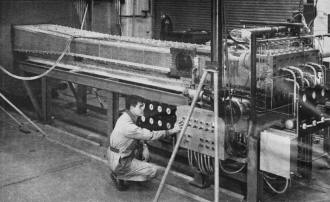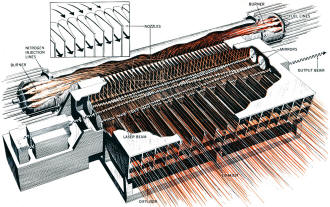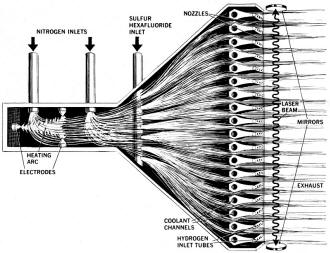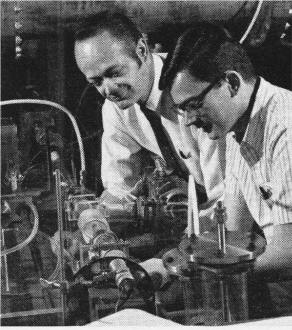|
March 1972 Popular Science
 [Table of Contents] [Table of Contents]
Wax nostalgic about and learn from the history of early
electronics. See articles from
Popular
Science, published 1872-2021. All copyrights hereby acknowledged.
|
Those of us who grew up in
the 1960s and 1970s were inundated with books, movies, television shows, magazines,
comic books, toys and other forms of promotion for the promises of lasers - both
fictional and real - remember seeing articles like this one in a 1972 issue of
Popular Science. Heck, there's a good chance I read this when it originally
came out. At the time, laser power levels were measured in the hundreds or maybe
a few thousands of watts. It wasn't long before that a watt produced from the lasing
in rubies was considered an accomplishment. By this time chemical lasers were (and
are today) the workhorses of laser weapons. Much of the state of the art in lasers
has always been a well-kept secret by military and government research and defense
contracting agencies. Interestingly, author Albright claims much of what he reports
was gleaned by assimilating bits of information from diverse sources. It's a good
example of the "loose lips sink ships" saying from World War II, whereby the
enemy can figure out what you are doing even without clandestine sources (aka spies)
embedded in the works.
Laser Weapons - How Close Are We?

Gas-dynamic laser - best weapon bet?
Lasers work by "pumping" atoms or molecules to a high-energy state. The atoms
decay to the normal state and get rid of excess energy by "lasing" - giving off
laser light. Most lasers are pumped with light or electrical energy. The gas-dynamic
laser uses heat. Burners are similar to rocket engines. The heated gases (nitrogen,
helium, or carbon dioxide) expand tremendously and rush out through the rocket-like
nozzles at supersonic speed. In the nozzles, the gases suddenly expand and cool.
By Nelson Albright
For a decade defense planners have desperately sought a laser heat weapon. Here's
the untold story of our secret - and successful-research program.
Illustrations by Ray Pioch
"The Incredible Laser," read the fading title page of a Sunday supplement taped
to a sun-drenched office door at Hughes Aircraft Company's posh research laboratories
overlooking the crystal blue Pacific at Malibu. The picture showed a beam of light
emerging from the barrel of a cannon - an obvious allusion nearly 10 years ago to
the fictional notion of a laser "death ray." Beneath the title was scribbled the
reply: "For the Credible Laser, See Inside."
The scientist-author of the gibe would have scoffed at any suggestion that within
a decade these quiet hill-top laboratories where the world's first laser was coaxed
into life only 12 years ago would be trying to help make that "incredible laser"
come true. Yet this is exactly what has happened as Hughes Aircraft and many other
research organizations have become involved in one of the most revolutionary technological
dramas in American history - the development of the laser radiation weapon.
We're Close to the Goal
While laser-weapon development projects are supersecret, some notion of progress
to date can be glimpsed by putting together bits from here and there. For example:
• Brig. Gen. Robert M. White, Commander of the Flight Test Center at Edwards
Air Force Base, told a meeting of experimental test pilots in Beverly Hills last
September that the Pentagon is backing the search for laser weapons much as it did
the development of the atomic bomb in World War II or the ICBM in the late 1950s.
• A Commerce Department publication that lists contracts recently listed
one between the Air Force and developers of the new B-1 bomber. It calls for an
investigation into the possibility of using a laser to defend the bomber against
fighters.

Through a complex process, the ratio of CO2 molecules
in a high-energy state increases with respect to those at a lower energy level,
bringing about the so-called "population inversion" needed for laser action. Lasing
takes place in the excited gas as the light beam bounces back and forth between
the mirrors. The high-speed gas flow gives another advantage: It carries away huge
amounts of heat created by the lasing action. A variation of the gas-dynamic laser,
the electro-aerodynamic laser, is similar but uses electrodes to heat the gas. It
offers one advantage: Gases can be recycled. Photo shows gas-dynamic laser built
by Avco.
• A similar weapon is under study for the Air Force's upcoming F-15 air-superiority
fighter. Vice Admiral Thomas J. Walker, head of naval air forces in the Pacific,
at the same meeting addressed by General White, called these "Buck Rogersish weapons"
potential successors to the 20mm gun of naval aircraft in Vietnam.
• Details are secret, but it has been learned that military researchers
have shot down at least one small drone aircraft with a laser beam.
• Grant Hansen, Assistant Secretary of the Air Force, told a House Committee
that defense officials think it possible to build a superpower laser system that
" ... could track a ballistic missile from a space-based defense system and kill
it over the country it was launched from." Code name for the project: Spade.
• Says a veteran researcher associated with the laser-weapon program from
its inception (but who could not allow his name to be used): "Laser thermal weapons
are practical if the military wants them."
The enticing notion of laser "death rays" sparked interest in lasers within the
Defense Department more than a year before the successful operation o a ruby laser
by a shy Hughes scientist, Dr. Ted Maiman, early in 1960.
Pentagon Was Fascinated
The prospect of a weapon projecting its destructive force over great distances,
at the speed of light, and with little diminution in its destructiveness was attractive
to defense planners. So they awarded a handful of early exploratory laser development
contracts even before Maiman had made the first laser work.
The big problem through the early sixties: A successful laser weapon would have
to generate incredible energy to destroy targets by heating them. But lasers at
that time, despite the remarkably high power densities of their beams, produced
relatively little sustained energy.
The invention of the highly efficient carbon dioxide laser in the mid-1960s rekindled
the never completely abandoned weapons effort. CO2 lasers have now been
built that can produce a continuous 60-thousand watt (60-kw) beam. But an even bigger
boost for weapons planners came about five years ago with the invention of the gas-dynamic
laser (see diagram). Gas-dynamic lasers now in operation achieve output powers of
hundreds of kilowatts, which may be sufficient for some weapons applications. A
short time later came yet another important development: the chemical laser (see
diagram). While this device is not presently as powerful as the gas-dynamic laser,
it has several characteristics that make it an ideal weapons candidate. Weapons
development scientists are working on both.
Before gas-dynamic and chemical lasers came along, the possibility of developing
a laser weapon was slim for two reasons. First, to get enough energy in the beam,
an enormous electrical power supply would be needed. Second, cooling of the laser
itself was a super-tough problem.
The two new lasers go a long way toward solving both problems. The reactant gases
flow through them at high speeds and carry off huge amounts of heat. And they require
little electrical power. The energy comes in one case from gases heated by a rocket-like
burner, in the other from a chemical reaction. And both are relatively light and
compact in proportion to their energy output when compared to conventional lasers
and the electrical power supplies they require.

Molecules in a chemical laser are pumped to a high-energy state
not by electrical or thermal energy but by a chemical reaction. In this version,
built by Aerospace Corp., jets of nitrogen introduced at left are heated by an electric
arc. The sudden heating forces them at supersonic speed to the right, where they
are mixed with sulfur hexafluoride. Finally, at far right, they are expanded through
a series of small nozzles similar to those in the gas-dynamic laser and hydrogen
is injected into the gas stream. The hydrogen combines with the atoms of fluorine
from the sulfur hexafluorine to produce excited hydrogen fluoride. A beam of infrared
energy is created as these excited molecules lase between the two mirrors. As in
the gas-dynamic laser, the rapid gas flow solves the cooling problem.

Chemical lasers are attractive candidates for weapons because
they require little or no electrical power and produce huge amounts of energy in
proportion to their size and weight. The photograph shows an experimental chemical
laser developed by Terrill A. Cool (left) of Cornell, shown here with graduate student
assistant, Ronald R. Stephens.
Most of the speculation about laser weapons has revolved around the old idea
of the "death ray." Although the new lasers could certainly kill or disable men
at great ranges, they won't be used for that. Current weapons-from rifles to hand
grenades-are cheaper, more portable, easier to use.
Military planners want lasers for use where their instant-reaction time and speed-of-light
delivery are important. For example, the laser offers, by its nature, a possible
solution to the toughest problem in ballistic missile defense: that of sorting real
warheads from decoys. The coherent output of a laser, like all electromagnetic energy,
travels at 186,000 miles per second - faster than any other weapon today.
If the laser could disable an incoming missile warhead, the defense would have
time-seconds, even minutes - to study the threat, make its decisions. It could even
hold fire until warheads and decoys penetrated the earth's atmosphere. The lighter
decoys would burn up, leaving only real targets. Then, with the speed of light,
a laser beam could impale a target.
Radar Tracking, Too
Still another advantage: A laser beam, like microwave energy, can be used for
radar. But its accuracy is far greater because of its shorter wavelength. The same
beam might initially serve at low energy as a radar tracker. When it had the missile
pinpointed, it could simply increase power and zap the target. This would totally
eliminate the usual costly, time-consuming computations of target trajectory needed
to calculate target intercept positions. Finally, the laser radiation weapon would
pour intense heat into a very small target area. It wouldn't atomize the target
as does the nuclear warhead of an antimissile missile. Thus, there would be negligible
danger of nuclear fallout.
While the real payoff from a laser weapon would be in protecting the country
from missile threats, other perhaps more immediate applications are attracting attention,
too. For example, the Navy is concentrating its radiation-weapon work on devices
designed to protect ships from ship-and air-launched cruise missiles. These deadly
weapons can be fired over the horizon against American ships by small enemy patrol
boats. The missiles hug the water surface, hiding themselves from intended victims
until it is too late for ship-based defenses to react. But laser beams can be swung
by the motion of mirrors alone. So designers can build inertia-less laser-defense
weapons that have nearly instantaneous coverage in any direction. The combination
of rapid self-tracking and instantaneous weapon slewing would be a natural solution
to the need for rapid shipboard reaction to naval cruise missiles.
Today, most U. S. laser radiation work is centered at the Weapons Laboratory
at Kirtland AFB, near Albuquerque, under the code name, "Eighth Card." (Kirtland
is where the target drone was shot down about two years ago.) It's run by the Air
Force, which is managing a tri-service effort supported by the three services and
Advanced Research Projects Agency. Work is also underway at government locations
in diverse locations: Boston, Dayton, Los Angeles, Huntsville. The two main industrial
contractors are United Aircraft's Florida Research and Development Center, W. Palm
Beach, and a team made up of Avco and Hughes Aircraft. Avco has concentrated on
laser devices; Hughes on laser pointing and tracking optics.
One by one, the objections of scientific doubters have been brushed aside by
an accumulation of encouraging evidence, turning a growing number of skeptics into
believers in laser thermal weapons. For example, the fear that laser beams exceeding
certain energy density would produce a ballooning effect in the atmosphere, causing
a sharp electrical breakdown akin to lightning, hasn't materialized. Atmospheric
absorption could be a severe problem, but primarily under a narrow set of conditions,
especially in the rare instance where both target and weapon are motionless on quiet
days. And the new high-powered lasers have shot down the old notion that it would
never be possible to build enough power into a unit small enough to be a practical
weapon.
But there are still many questions: How quickly can a thermal weapon of given
energy density destroy a target? In some instances, it may take longer than a bullet
or a cannon shell, but may still be worth the price.
How susceptible is military hardware? Researchers must find out. Then they can
figure how much laser power it will take to destroy or damage various kinds of equipment
The Air Force is looking at the impact of laser radiation on jet-aircraft engine
fuels, turbine-engine blades, fuel cells, weapons fuses, high explosives, and materials
of all kinds. In one experiment, the Pyroceram nose cone of a standard tactical
missile fractured into countless pieces after one square centimeter of its surface
was blasted for a half second by a laser delivering only one kilowatt.
Laser Test Ranges
To expand the investigations, the Air Force put into operation at an isolated
spot in the Manzano mountain range within 25 miles of Albuquerque the first of three
laser-weapons-firing test ranges, each to be operated by one of the three services.
There, high-energy lasers located on one side of a barren scrub-pocked valley are
fired at two simulated targets across the valley. The laser and target locations
are chosen to insure beam paths at different heights. At the Manzano range, not
too far from where the first atomic bomb was exploded outside Alamogordo, the Air
Force expects to isolate and analyze the effects on the optical path of airborne
particles, air turbulence, and ground interactions.
Historically, every weapon has produced a counterweapon. Laser thermal weapons
may be no exception. Mirrored surfaces that reflect incident light are an obvious
- but not necessarily practical - answer. Highly reflecting surfaces on aircraft
would compromise the vehicle's aerodynamic qualities. Tank surfaces can be made
reflective, but quickly they would be pitted with sand and dust during normal military
operations ruining their reflective properties Artificially generated plasmas and
water vapor may offer other solutions now under study.
The imminence of laser weapons is difficult to predict because tough engineering
- not scientific - problems still have to be solved. But odds are - they'll be in
our future soon.
Posted December 15, 2023
|













